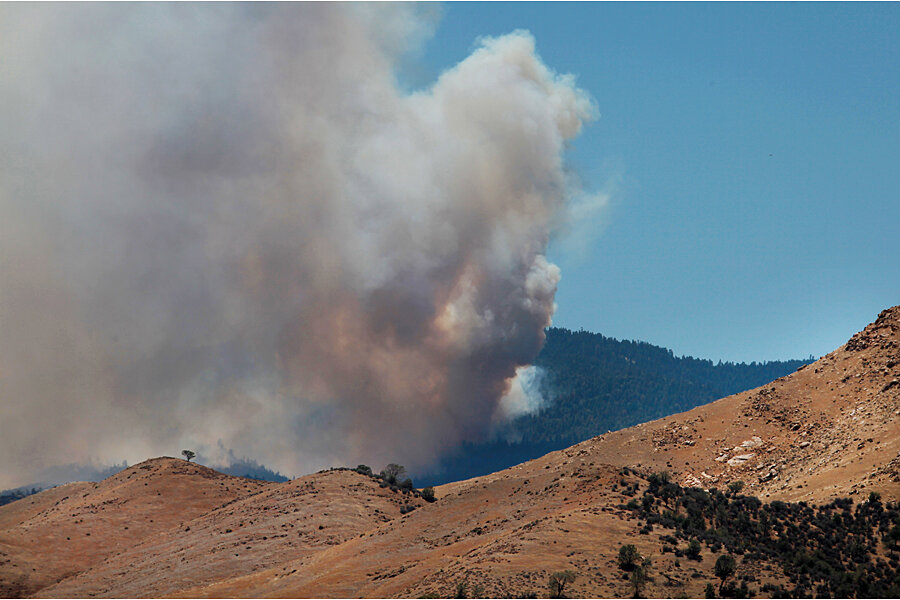California wildfire being tamed, but is state near breaking point for fires?
Loading...
| Los Angeles
In the past few days, southern California firefighters and homeowners have gone through an all-too-familiar drill, as a wildfire broke out just northeast of Bakersfield. Some 2,646 acres have been scorched, and 1,000 homes were threatened – although as of early Tuesday, the fire was 75 percent contained, and evacuations were called off.
Because the affected area is in and near Sequoia National Forest – home to historic stands of giant sequoias – the blaze has gotten heightened attention, experts say.
So far this year, California has endured a total of 1,244 wildfires – triple the average. And no letup is predicted.
While currently, 6 million to 8 million acres defines a “bad” fire season in the state, an average of 10 million to 12 million acres will burn annually in the near future, predicts Firefighters United for Safety, Ethics and Ecology (FUSEE) in Eugene, Ore. Also, California’s fire season has gone from an average of four months to pretty much year-round.
Some are worried that a breaking point is coming.
“We will burn through all our suppression money, and by late August, when it’s really hot in southern California, the firefighters will be utterly exhausted,” says Timothy Ingalsbee, executive director of FUSEE.
A number of factors are cited for the burgeoning number of fires, including a record-breaking drought, a heat wave, and past fire suppression practices that have allowed the long-term buildup of biomass, which can fuel mega-fires. But many sociologists single out the following conclusion: that Californians have not learned the downside of living in what is known as the wildland-urban interface.
“I hate to sound so discouraging, but I don’t think we’re making the progress we should,” says former smoke jumper Jan van Wagtendonk, who is also a retired fire ecologist at Yosemite National Park in California. “When these major fires are over, devastating homes and property, we just keep moving back in and doing the exact same things over and over and over.”
True, with some of the larger fires have come new building and fire codes and new brush regulations. But no matter how much fire-retardant roofing is used and brush abatement is done, the fact remains that forests continue to burn naturally, point out Mr. van Wagtendonk and others.
Char Miller, professor of environmental analysis at Pomona College in Claremont, Calif., says he just visited a community in Oakland, Calif., that was ravaged by fire in 1991 – killing 25 people, injuring 150 others, and destroying 3,354 single-family dwellings and 437 apartment and condominium units. The economic loss has been estimated at $1.5 billion.
Twenty-three years later, 70 percent of homeowners there are rebuilders from 1991, and the “houses are bigger and the vegetation is back,” Professor Miller says.
“As a society, we have been ramping up on the firefighting side of the equation – giving more money for equipment and firefighters – but not on the social side,” he says.
Indeed, a sizable amount of money and resources have been allocated to deal with wildfires. By van Wagtendonk’s estimation, wildfire suppression costs in the United States are soaring above 1 billion tax dollars per year.
For the so-called Shirley Fire near Bakersfield, more than 1,600 firefighters were working around the clock, costing $7.2 million as of Tuesday morning.
The fire, which started Friday and is of unknown origin, destroyed three homes and damaged another.
An irony of the Shirley Fire is that sequoias actually need fire, says Mr. Ingalsbee, who was formerly a wildland firefighter for the US Forest Service and National Park Service.
“They are throwing an incredible amount of money at stopping the very process the sequoias need to thrive,” he says. “Instead of developing a program of steady burning off of underbrush, we let the fuel accumulate to the point where fires are too big and hot to fight.”
The so-called Rim Fire last year also made headlines because of its proximity of sequoias. Those trees are in Yosemite National Park.





